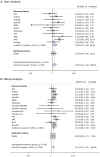Stratifying type 2 diabetes cases by BMI identifies genetic risk variants in LAMA1 and enrichment for risk variants in lean compared to obese cases
- PMID: 22693455
- PMCID: PMC3364960
- DOI: 10.1371/journal.pgen.1002741
Stratifying type 2 diabetes cases by BMI identifies genetic risk variants in LAMA1 and enrichment for risk variants in lean compared to obese cases
Abstract
Common diseases such as type 2 diabetes are phenotypically heterogeneous. Obesity is a major risk factor for type 2 diabetes, but patients vary appreciably in body mass index. We hypothesized that the genetic predisposition to the disease may be different in lean (BMI<25 Kg/m²) compared to obese cases (BMI≥30 Kg/m²). We performed two case-control genome-wide studies using two accepted cut-offs for defining individuals as overweight or obese. We used 2,112 lean type 2 diabetes cases (BMI<25 kg/m²) or 4,123 obese cases (BMI≥30 kg/m²), and 54,412 un-stratified controls. Replication was performed in 2,881 lean cases or 8,702 obese cases, and 18,957 un-stratified controls. To assess the effects of known signals, we tested the individual and combined effects of SNPs representing 36 type 2 diabetes loci. After combining data from discovery and replication datasets, we identified two signals not previously reported in Europeans. A variant (rs8090011) in the LAMA1 gene was associated with type 2 diabetes in lean cases (P = 8.4×10⁻⁹, OR = 1.13 [95% CI 1.09-1.18]), and this association was stronger than that in obese cases (P = 0.04, OR = 1.03 [95% CI 1.00-1.06]). A variant in HMG20A--previously identified in South Asians but not Europeans--was associated with type 2 diabetes in obese cases (P = 1.3×10⁻⁸, OR = 1.11 [95% CI 1.07-1.15]), although this association was not significantly stronger than that in lean cases (P = 0.02, OR = 1.09 [95% CI 1.02-1.17]). For 36 known type 2 diabetes loci, 29 had a larger odds ratio in the lean compared to obese (binomial P = 0.0002). In the lean analysis, we observed a weighted per-risk allele OR = 1.13 [95% CI 1.10-1.17], P = 3.2×10⁻¹⁴. This was larger than the same model fitted in the obese analysis where the OR = 1.06 [95% CI 1.05-1.08], P = 2.2×10⁻¹⁶. This study provides evidence that stratification of type 2 diabetes cases by BMI may help identify additional risk variants and that lean cases may have a stronger genetic predisposition to type 2 diabetes.
Conflict of interest statement
The authors have declared that no competing interests exist.
Figures






References
-
- Tsai FJ, Yang CF, Chen CC, Chuang LM, Lu CH, et al. A genome-wide association study identifies susceptibility variants for type 2 diabetes in Han Chinese. PLoS Genet. 2010;6:e1000847. doi: 10.1371/journal.pgen.1000847. - DOI - PMC - PubMed
-
- Yamauchi T, Hara K, Maeda S, Yasuda K, Takahashi A, et al. A genome-wide association study in the Japanese population identifies susceptibility loci for type 2 diabetes at UBE2E2 and C2CD4A-C2CD4B. Nat Genet. 2010;42:864–868. - PubMed
Publication types
MeSH terms
Substances
Grants and funding
- U01 HG004728/HG/NHGRI NIH HHS/United States
- U01 HG004415/HG/NHGRI NIH HHS/United States
- R01 HL087641/HL/NHLBI NIH HHS/United States
- U01 CA136792/CA/NCI NIH HHS/United States
- R01 DK078616/DK/NIDDK NIH HHS/United States
- HHSN268201100012C/HL/NHLBI NIH HHS/United States
- UL1RR025005/RR/NCRR NIH HHS/United States
- CA54281/CA/NCI NIH HHS/United States
- N02-HL-6-4278/HL/NHLBI NIH HHS/United States
- N01-HC-25195/HC/NHLBI NIH HHS/United States
- CZB/4/710/CSO_/Chief Scientist Office/United Kingdom
- U01HG004726/HG/NHGRI NIH HHS/United States
- P01CA089392/CA/NCI NIH HHS/United States
- HHSN268201100009I/HL/NHLBI NIH HHS/United States
- U10AA008401/AA/NIAAA NIH HHS/United States
- R56 DK062370/DK/NIDDK NIH HHS/United States
- R01HL59367/HL/NHLBI NIH HHS/United States
- HHSN268201100010C/HL/NHLBI NIH HHS/United States
- UL1 RR025005/RR/NCRR NIH HHS/United States
- U01HG004738/HG/NHGRI NIH HHS/United States
- HHSN268201100008C/HL/NHLBI NIH HHS/United States
- HHSN268201100005G/HL/NHLBI NIH HHS/United States
- Z01 CP010200/ImNIH/Intramural NIH HHS/United States
- HHSN268201100008I/HL/NHLBI NIH HHS/United States
- U01HG004415/HG/NHGRI NIH HHS/United States
- U01 DE018993/DE/NIDCR NIH HHS/United States
- R01 HL059367/HL/NHLBI NIH HHS/United States
- U01HG004735/HG/NHGRI NIH HHS/United States
- HHSN268201100007C/HL/NHLBI NIH HHS/United States
- MC_U127561128/MRC_/Medical Research Council/United Kingdom
- P01 CA089392/CA/NCI NIH HHS/United States
- R01 DK072193/DK/NIDDK NIH HHS/United States
- HHSN268201100011I/HL/NHLBI NIH HHS/United States
- HHSN268201100011C/HL/NHLBI NIH HHS/United States
- R01 HL086694/HL/NHLBI NIH HHS/United States
- U01 HG004402/HG/NHGRI NIH HHS/United States
- U01HG004728/HG/NHGRI NIH HHS/United States
- U01HG004399/HG/NHGRI NIH HHS/United States
- U01HG004402/HG/NHGRI NIH HHS/United States
- U01HG004422/HG/NHGRI NIH HHS/United States
- CA63464/CA/NCI NIH HHS/United States
- R01 DK062370/DK/NIDDK NIH HHS/United States
- R01 HL105756/HL/NHLBI NIH HHS/United States
- R01DA013423/DA/NIDA NIH HHS/United States
- U01 HG004729/HG/NHGRI NIH HHS/United States
- DK072193/DK/NIDDK NIH HHS/United States
- MC_U106179471/MRC_/Medical Research Council/United Kingdom
- HHSN268201100006C/HL/NHLBI NIH HHS/United States
- 083270/Z/07/Z/WT_/Wellcome Trust/United Kingdom
- U01 HG004422/HG/NHGRI NIH HHS/United States
- N01 HC025195/HL/NHLBI NIH HHS/United States
- R01HL087641/HL/NHLBI NIH HHS/United States
- MC_PC_U127592696/MRC_/Medical Research Council/United Kingdom
- HHSN268201100005I/HL/NHLBI NIH HHS/United States
- R01 DA013423/DA/NIDA NIH HHS/United States
- R01 CA063464/CA/NCI NIH HHS/United States
- K24 DK080140/DK/NIDDK NIH HHS/United States
- U01DE018993/DE/NIDCR NIH HHS/United States
- MC_PC_U127561128/MRC_/Medical Research Council/United Kingdom
- 090532/WT_/Wellcome Trust/United Kingdom
- U01HG004423/HG/NHGRI NIH HHS/United States
- R01 CA054281/CA/NCI NIH HHS/United States
- U01DE018903/DE/NIDCR NIH HHS/United States
- U01 CA063464/CA/NCI NIH HHS/United States
- U01HG004436/HG/NHGRI NIH HHS/United States
- 064890/WT_/Wellcome Trust/United Kingdom
- U01 DK062370/DK/NIDDK NIH HHS/United States
- U01HG004729/HG/NHGRI NIH HHS/United States
- DK062370/DK/NIDDK NIH HHS/United States
- U01 DE018903/DE/NIDCR NIH HHS/United States
- U01 HG004436/HG/NHGRI NIH HHS/United States
- HHSN268201100009C/HL/NHLBI NIH HHS/United States
- HHSN268201100005C/HL/NHLBI NIH HHS/United States
- U01 HG004735/HG/NHGRI NIH HHS/United States
- P30 DK020572/DK/NIDDK NIH HHS/United States
- HHSN268201100007I/HL/NHLBI NIH HHS/United States
- U01 HG004738/HG/NHGRI NIH HHS/United States
- U10 AA008401/AA/NIAAA NIH HHS/United States
- U01 HG004423/HG/NHGRI NIH HHS/United States
- MC_U127592696/MRC_/Medical Research Council/United Kingdom
- R37 CA054281/CA/NCI NIH HHS/United States
- U01 HG004399/HG/NHGRI NIH HHS/United States
- CA136792/CA/NCI NIH HHS/United States
- 081682/WT_/Wellcome Trust/United Kingdom
- G0601261/MRC_/Medical Research Council/United Kingdom
- R01HL086694/HL/NHLBI NIH HHS/United States
- U01 HG004726/HG/NHGRI NIH HHS/United States

